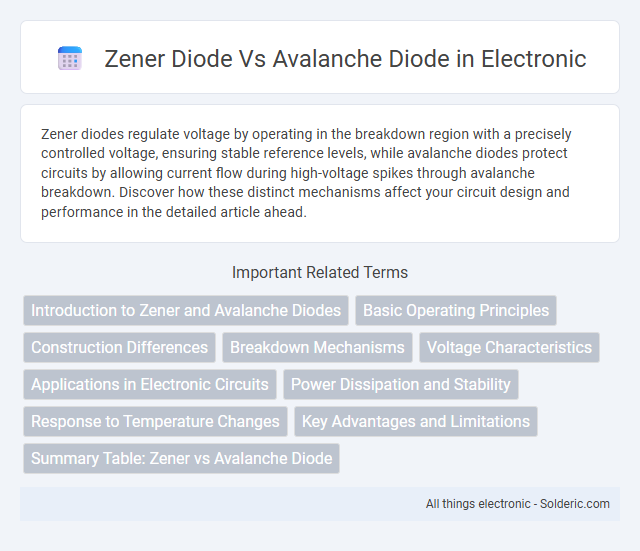Zener diodes regulate voltage by operating in the breakdown region with a precisely controlled voltage, ensuring stable reference levels, while avalanche diodes protect circuits by allowing current flow during high-voltage spikes through avalanche breakdown. Discover how these distinct mechanisms affect your circuit design and performance in the detailed article ahead.
Comparison Table
| Feature | Zener Diode | Avalanche Diode |
|---|---|---|
| Breakdown Mechanism | Zener Breakdown (Quantum Tunneling) | Avalanche Breakdown (Carrier Multiplication) |
| Voltage Range | Typically below 5.6V | Typically above 5.6V |
| Application | Voltage Regulation, Voltage Reference | Overvoltage Protection, High Voltage Clamping |
| Temperature Stability | Negative Temperature Coefficient | Positive Temperature Coefficient |
| Construction | Heavily Doped PN Junction | Lightly Doped PN Junction |
| Breakdown Voltage Sharpness | Sharp and Well-Defined | Less Sharp, Controlled by Avalanche Effect |
| Typical Usage | Low voltage stabilization circuits | High voltage surge protection devices |
Introduction to Zener and Avalanche Diodes
Zener diodes operate based on the Zener breakdown mechanism, allowing controlled voltage regulation by maintaining a stable reverse voltage. Avalanche diodes rely on avalanche breakdown, where a high reverse voltage causes impact ionization, enabling high-speed switching and protection in circuits. Both diodes are critical for voltage stabilization but differ in breakdown voltage ranges and response characteristics.
Basic Operating Principles
Zener diodes operate on the principle of controlled breakdown at a specific reverse voltage known as the Zener voltage, enabling voltage regulation by maintaining a stable reference voltage. Avalanche diodes function based on avalanche breakdown, where carriers multiply due to impact ionization when reverse voltage exceeds a critical value, making them suitable for protecting circuits from voltage spikes. While both diodes conduct in reverse bias during breakdown, Zener diodes dominate at lower voltages (typically below 5V), and avalanche diodes are effective at higher voltages, relying on different physical mechanisms.
Construction Differences
Zener diodes are designed with a heavily doped p-n junction to enable controlled breakdown at lower voltages, typically below 5-6V, resulting in a sharp and stable breakdown voltage. Avalanche diodes feature a lightly doped p-n junction that allows breakdown at higher voltages through avalanche multiplication, producing a gradual and higher energy breakdown region. Understanding these construction differences helps you select the right diode type for voltage regulation or surge protection in electronic circuits.
Breakdown Mechanisms
Zener diodes operate based on Zener breakdown, which occurs at lower reverse voltages due to strong electric fields causing quantum mechanical tunneling. Avalanche diodes rely on avalanche breakdown, where charge carriers gain enough kinetic energy to ionize atoms and create a chain reaction at higher reverse voltages. Zener breakdown typically dominates below 5-6 volts, while avalanche breakdown is prevalent at voltages above this threshold.
Voltage Characteristics
Zener diodes exhibit a sharp breakdown voltage typically between 2.4V and 7V, where they maintain a stable voltage despite changes in current, making them ideal for voltage regulation. Avalanche diodes, in contrast, have higher breakdown voltages usually above 6V, relying on avalanche multiplication to conduct and offering a more gradual voltage transition during breakdown. Both types provide reliable voltage stabilization but differ significantly in their voltage characteristics and applications due to their distinct breakdown mechanisms.
Applications in Electronic Circuits
Zener diodes are primarily used for voltage regulation, providing stable reference voltages in power supplies and protecting circuits from voltage spikes by clamping excess voltage. Avalanche diodes excel in high-speed switching and transient voltage suppression due to their ability to handle higher energy levels without damage, making them ideal for electrostatic discharge (ESD) protection and surge suppression applications. Your choice between these diodes depends on whether the focus is on precise voltage regulation or robust transient protection in electronic circuit design.
Power Dissipation and Stability
Zener diodes provide stable voltage regulation with lower power dissipation under normal operating conditions due to their sharp breakdown voltage characteristics. Avalanche diodes handle higher power dissipation more effectively during transient surge events, offering superior stability under large voltage spikes. Understanding these differences ensures your circuit maintains optimal performance and longevity in voltage protection applications.
Response to Temperature Changes
Zener diodes exhibit a negative temperature coefficient at breakdown voltages below 5.6V, meaning their breakdown voltage decreases as temperature rises, making them suitable for voltage regulation in low-voltage applications. Avalanche diodes have a positive temperature coefficient, with breakdown voltage increasing as temperature elevates, which ensures more stable operation at higher voltages. This contrasting temperature response allows engineers to select diodes based on thermal stability requirements in voltage reference or protection circuits.
Key Advantages and Limitations
Zener diodes offer precise voltage regulation with low breakdown voltage and fast response, making them ideal for voltage references in low-voltage circuits. Avalanche diodes provide higher breakdown voltage and better reliability under transient high-voltage conditions but have higher noise levels and slower recovery times. Understanding your application's voltage and noise tolerance helps determine whether a Zener or avalanche diode is more suitable for efficient and stable circuit performance.
Summary Table: Zener vs Avalanche Diode
A Zener diode operates primarily in the breakdown region using Zener effect at lower voltages, typically below 5V, while an avalanche diode relies on avalanche multiplication at higher voltages, usually above 5V. Zener diodes exhibit sharp voltage regulation with relatively low noise, making them ideal for voltage reference applications, whereas avalanche diodes handle higher power, provide robust surge protection, and feature higher breakdown voltage and current ratings. The breakdown voltage of Zener diodes ranges from 2.4V to 200V, contrasted by avalanche diodes which start from about 5V extending into kilovolts, highlighting their distinct operational domains in electronic circuits.
zener diode vs avalanche diode Infographic

 solderic.com
solderic.com